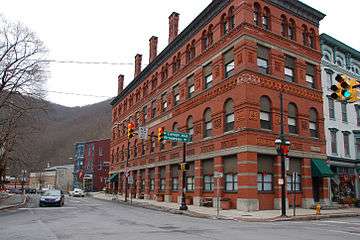Mauch Chunk station (Central Railroad of New Jersey)
Mauch Chunk | ||||||||||||||||
|---|---|---|---|---|---|---|---|---|---|---|---|---|---|---|---|---|
| Central Railroad of New Jersey Station | ||||||||||||||||
|
Central Railroad of New Jersey Station | ||||||||||||||||
| Location | Susquehanna Street, Jim Thorpe, Pennsylvania | |||||||||||||||
| Tracks | 2 | |||||||||||||||
| Construction | ||||||||||||||||
| Disabled access | No | |||||||||||||||
| Electrified | No | |||||||||||||||
| Services | ||||||||||||||||
|
No services
| ||||||||||||||||
|
Central Railroad of New Jersey Station | ||||||||||||||||
  | ||||||||||||||||
| Coordinates | 40°51′46″N 75°44′19″W / 40.86278°N 75.73861°WCoordinates: 40°51′46″N 75°44′19″W / 40.86278°N 75.73861°W | |||||||||||||||
| Area | 0.5 acres (0.20 ha) | |||||||||||||||
| Built | 1888 | |||||||||||||||
| Architect |
Wilson Brothers & Company Neast & Co. | |||||||||||||||
| Architectural style | Queen Anne | |||||||||||||||
| NRHP Reference # | 76001615[1] | |||||||||||||||
| Added to NRHP | January 1, 1976 | |||||||||||||||
The Central Railroad of New Jersey Station, also known as the Jersey Central Station and Jim Thorpe Station, is a historic railroad station located at Jim Thorpe, Carbon County, Pennsylvania. It was designed by Wilson Brothers & Company of Philadelphia, Pennsylvania, and built in 1888 by the Central Railroad of New Jersey. It is a 1 1/2-story, five bay, red brick building in the Queen Anne style. It features a 3 1/2-story, cylindrical corner tower with a cylindrical roof.[2]

History
The current station replaced an important rail terminus sharing passenger traffic with the CNJ predecessor & owner Lehigh and Susquehanna Railroad, and the Lehigh Valley Railroad—for both served the important head end of the busy (lower) Lehigh Canal. The station was located directly across the street from the Railroad's Pennsylvania landlord, the Lehigh Coal and Navigation Company (LC&N) whose headquarters was designed and built by the same architects when the corporation relocated to Mauch Chunk that same decade. The CNJ, an operating company, in general did not originally build nor own outright their Pennsylvania trackage, but instead had in the 1870s leased the various railroad and railroad lands developed by LC&N or LH&S— all of which came to be operated by the Lehigh and Susquehanna Railroad (LH&S), the main railroad subsidiary of the LC&N. In the early days of railroading, it was often easier to get stock subscribers for a particular shortline stretch, and hope it would be bought out by a larger company with deeper pockets—which accounts for why there are so many defunct shortline railroads. Until the 1870s, and the passing of both its founders, the Lehigh Coal and Navigation Company, whose latter day corporate offices were built directly across the street from the station, was a major regional player in actually building or bankrolling new road grades. Originally, LC&N in 1827 built the Summit Hill & Mauch Chunk Railroad, the countries second railway which terminated in Mauch Chunk (Jim Thorpe) to feed the LC&N's Lehigh Canal, the highly demanded anthracite coal mined by the LC&N's miners. By the time the CNJ took over railroad operations, LC&N had owned most of the lands or the mineral rights along a nine-mile stretch to the west at Tamaqua—the destination of one of the companies several other railroad joint ventures. The station was added to the National Register of Historic Places on January 1, 1976.[1] It is located in the Old Mauch Chunk Historic District.
See also
References
- 1 2 National Park Service (2009-03-13). "National Register Information System". National Register of Historic Places. National Park Service.
- ↑ "National Historic Landmarks & National Register of Historic Places in Pennsylvania" (Searchable database). CRGIS: Cultural Resources Geographic Information System. Note: This includes David M. Berman (1975). "National Register of Historic Places Inventory Nomination Form: Central Railroad of New Jersey Station" (PDF). Retrieved 2012-10-30.
- Clint Chamberlin. "LEHIGH AND SUSQUEHANNA DIVISION". North East Rails. Retrieved 14 September 2013.
External links
- Historic American Engineering Record (HAER) No. PA-170, "Central Railroad of New Jersey, Jim Thorpe Station, Jim Thorpe, Carbon County, PA", 1 photo, 1 photo caption page
| Wikimedia Commons has media related to Central Railroad of New Jersey Station (Jim Thorpe, Pennsylvania). |

